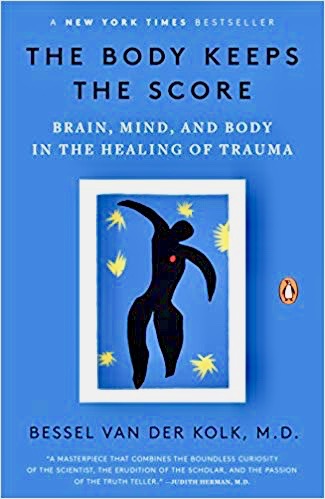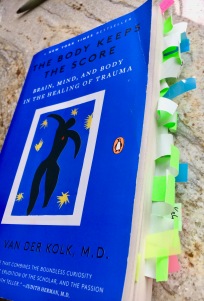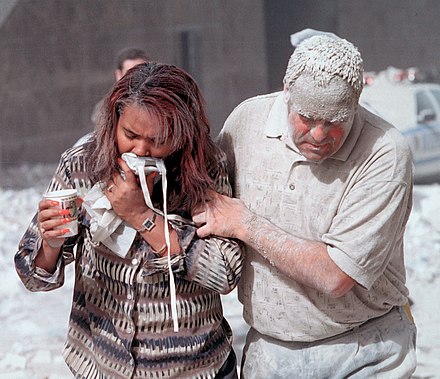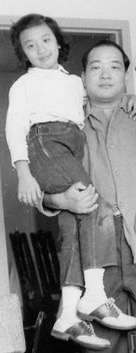

I flagged so many pages of Bessel van der Kolk’s The Body Keeps Score that it became kind of ridiculous. But it is that important. Van der Kolk is a psychiatrist who has spent over thirty years working with trauma survivors. He has worked with patients with PTSD, victims of natural and man-made disasters, and people who were abused or neglected as children, including clergy sexual abuse victims. The Body Keeps Score explains the physical basis for trauma symptoms and offers a plethora of effective treatments. This is tremendously hopeful.
Here are the critically important breakthroughs he describes:
- Van der Kolk offers anatomic and physiologic correlations to the symptoms that trauma victims exhibit: fight, flight or freeze. This is akin to correlating someone’s belly pain to the x-rays of gallstones. This approach lays down a scientific framework for many of the psychological treatments that are based on theories (psychodynamic, cognitive, behavioral, etc.) that are not anchored to what is actually happening in the body.
- The treatment of traumatic injury is urgent because, according to van der Kolk, “[b]eing traumatized is not just an issue of being stuck in the past; it is just as much a problem of not being fully alive in the present.” (italics mine.) People five, ten, twenty years out from their trauma cannot fully experience their current lives.
- According to van der Kolk, child abuse is “the gravest and most costly public health issue in the United States.” “[E]radicating child abuse in America would reduce the overall rate of depression by more than half, alcoholism by two-thirds, and suicide, IV drug use, and domestic violence by three-quarters.”
- Prevention is the best solution. “… [S]ocial support is the most powerful protection against becoming overwhelmed by stress and trauma … being truly heard and seen by the people around us, feeling that we are held in someone else’s mind and heart.”
Van der Kolk describes many victims of trauma suffering from “timeless reliving; re-experiencing images, sounds, and emotions; and dissociation.” While writing this essay, I heard a radio interview with Garrett Graff, author of a new book of oral histories about 9/11. He said that, in talking to people who lived through that day, he was struck by people reliving their sensory experiences: the taste of the dust and the feel of the ashes all around them; the feel of the heat; the ankle to knee-deep water (from the sprinklers) they waded through to get out.

Van der Kolk’s research shows that many kinds of treatment are helpful. He divides therapy into two categories: “top down” and “bottom up.” By top down, he means treatments that require language. These include cognitive behavioral therapy, mindfulness, EMDR (eye movement desensitization and reprocessing), writing and art. The “bottom up” approach uses the body’s sensory awareness to soothe the brain. (The body sends as many messages to the brain as the brain sends to the body.) These include yoga, dance therapy, Heartmath, Pilates, theater and more. He is not against medications. They have their place.
My own experience of trauma seems very mild compared to van der Kolk’s patients or the 9/11 victims. Some years ago, we had a birdhouse on a tree that overlooked our back porch. Eurasian tree sparrows had set up household. We eagerly awaited the babies. Then, one day, a male house sparrow stuck his head in the hole and pulled out a naked, half-formed chick, maybe an inch and a half long with little bits of fuzz. It laid on the wooden porch boards. The violence of it unnerved me.
When I was in college, my boyfriend took me to the home of one of his friends. We were all chatting. The wife — I think her being Asian made it more distressing to me — came in and said something to her husband. Without warning, he started chasing her around the room and hitting her with a pair of slippers.

When I was a kid in Hong Kong, all the kids in our little neighborhood ran to the man who hawked sweet soy bean curds. There would be a mob of kids twenty strong. I joined them. We brought our little bowls for him to fill. As he did this, he ran his fingers through our genitals. He was so fast and stealthy. Two questions stayed with me. What did he get out of it and why did we keep going to him?

Logically, the real trauma of my life was not having a dad until I was eight years old. He left China when I was one. We (my mom, my sister and me) joined him in America seven years later. In trying to get to America, we moved from Shanghai to Hong Kong. This required learning new languages. Then, learning English, of course. Traumatic? I don’t know. Two results. I am a more reluctant traveler than many (Peace Corps? Go somewhere where you don’t know the language or how to get around? Been there, done that!) Also, I always felt I needed to protect my parents in this new land. I imagine it’s a common immigrant story. When I think about it though, there were hardly two more competent people than my parents.
As you can infer, Bessel van der Kolk is brilliant and energetic. He is also deeply compassionate. He states, “It is much more productive to see aggression or depression, arrogance or passivity as learned behaviors: Somewhere along the line, the patient came to believe that he or she could survive only if he or she was tough, invisible, or absent, or that it was safer to give up. Like traumatic memories that keep intruding until they are laid to rest, traumatic adaptations continue until the human organism feels safe and integrates all the parts of itself that are stuck in fighting or warding off the trauma.” I am not always so charitable. Sometimes, I think arrogant people are just jerks.
Trauma sufferers have a great advocate in Bessel van der Kolk. The Body Keeps Score gives hope both in unravelling the physical reasons for trauma symptoms and in offering a review of a wide range of effective treatments.
Tell me: Do you know of a “bottom up” treatment program that one wouldn’t necessarily associate with treating trauma?
I give my vote to Prison Performing Arts. Van der Kolk states that humans have been re-integrating war veterans back into society through ritual since the Greek tragedies. This organization puts on plays by people in Missouri’s prisons. I have been to a performance by women in the Vandalia Correctional Center.

5 replies on “The Body Keeps Score”
Thanks for your compelling blog.
It made me dig deep into my
“traumas” and why it is so difficult
To release them from ourselves.
Nancy Klepper
LikeLiked by 1 person
❤️❤️❤️❤️
LikeLike
I find this essay to be incredibly reassuring. There IS no separation between the mind and body. How crazy that mankind ever thought so. I remember a quote from Maharishi Mahesh Yogi (the T.M. teacher) … “The mind and body are best friends. They go everywhere together.”
In my experience, both “top down” and “bottom up” therapies work:
• a brisk walk helps alleviate a panic attack;
• antidepressants and psychotherapy increase the effectiveness of chronic pain meds; and
• a kind, attentive healthcare provider enhances the success of any medical treatment.
LikeLike
Walter’s Walk is exactly the kind of place that treats trauma, as van der Kolk calls, “bottom up.” So happy you have found comfort, support and community there. 💕
LikeLike
Cathy, thanks for your review of this wonderful book. I have been receiving massage therapy at a nonprofit counseling center in Hazelwood, Walter’s Walk, named after the director’s father. Walter’s Walk specializes in treating trauma, as well as anxiety, depression, OCD. I suffered complex trauma during childhood, and developed an eating disorder and obesity. Massage therapy that is trauma- informed, has been very powerful in helping me get in touch with my physical self , which was numb, locked.
LikeLike